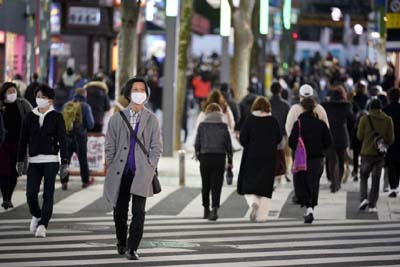
Japan firms slash biz investment for the third straight quarter
Tokyo: Firms in Japan slashed spending on plant and equipment for the third straight quarter in October-December as manufacturers cut costs, casting doubt on the strength of the country’s recovery as the COVID-19 pandemic hit private demand.
Weakness in capital expenditure is likely to worry policymakers counting on private-sector investment to help the world’s third-largest economy decisively shake off the health crisis.
Separate data painted a more optimistic picture of the nation’s job market in January.
Capital spending fell 4.8% in October-December compared with the same period a year earlier, data from the Finance Ministry showed Tuesday, posting a third straight quarter of declines following a 10.6% drop in July-September.
“Manufacturers are clearly cutting costs,” said Takeshi Minami, chief economist at Norinchukin Research Institute.
“As they’re seeing a recovery on the back of increased China and U.S.-bound exports, they’re firmly securing profits — but on the other hand they’re making quite an effort to reduce costs,” he added.
Business expenditure shrank 0.3% quarter-on-quarter on a seasonally adjusted basis, the data showed, with manufacturers slashing investments, including on software, at a faster pace and for the third straight quarter.
Analysts said the capex data suggested a downward revision to fourth-quarter gross domestic product (GDP) data due March 9.
A preliminary estimate released last month showed Japan’s economy expanded an annualized 12.7% in the last quarter.
Before the health crisis hit, capital spending had been a bright spot in the nation’s export-reliant economy, driven by investment in automation and the high-tech sector as firms sought to cope with labor shortages in its graying society.
Ordinary corporate profits dropped 0.7% in October-December compared with the same period a year before, extending declines to their seventh straight quarter.
While manufacturers posted the first increase in ordinary profits in 10 quarters year-on-year, their business spending fell 8.5% compared to the same period a year earlier.

Service-sector spending shed 2.6% year-on-year, following the third quarter’s 10.8% decrease, according to Tuesday’s survey, which was conducted among firms with at least ¥10 million in capital.
Sales dropped 4.5% year-on-year in October-December, down for the 6th straight quarter and slowing further from the previous period’s 11.5% decline.
The jobless rate was unchanged at 2.9% in January from the previous month. Job availability climbed to 1.10 from the prior month’s revised 1.05, hitting its highest since June last year when the ratio stood at 1.12, labor ministry data showed.
“New job offers should rebound soon and lead to a further pickup in employment as the economy resumes its recovery,” said Tom Learmouth, Japan economist at Capital Economics.
“We expect employment growth to consistently outpace labor force growth this year.”
The jobs data indicated the immediate impact of the country’s second coronavirus state of emergency was limited.
Japan declared its second state of emergency in early January in the Tokyo metropolitan area and expanded it later, asking dining establishments to close early and people to refrain from unnecessary outings. The outbreak has led to a growing number of bankruptcies.
“We can’t deny that the impact of the pandemic was felt, but concerns that the state of emergency would worsen (the jobless rate) did not materialize,” an official from the internal affairs ministry said.
The relative resilience of the labor market can be partly attributed to the limited scope of the latest state of emergency that covered just 11 of the country’s 47 prefectures, the official said. The previous emergency declaration covered the whole nation and was fully lifted in May.
Bearing the brunt of the pandemic, the services sector including hotels and restaurants shed jobs. The medical and welfare sector added workers.
Economists say jobs data is a lagging indicator of the state of the economy and the impact of the latest state of emergency may appear in coming months. Tokyo and the three neighboring prefectures of Saitama, Kanagawa and Chiba are still under the state of emergency that is scheduled to end March 7.
Government support for companies seeking to hold onto their employees has also helped prevent a sharp deterioration in employment conditions, allowing the unemployment rate to hover around 3% in recent months.
